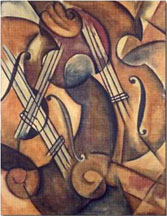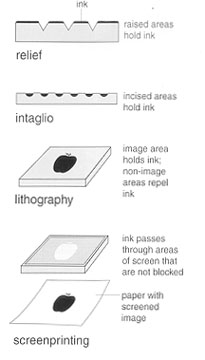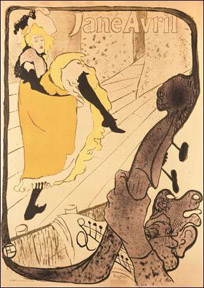.
Printmaking
History and Techniques

Hand Print from Chauvet cave, 28,000 BCE |

Swiss Playing Cards, woodblock print,1745 |
Long before the printing press was invented, printmaking was a medium of
communication. The first evidence of the use of a stencil to create an image
was found in the cave paintings in France and Spain. Prehistoric man placed
his hand on the wall of the cave and blew pulverized pigment around it.
The ancient Sumerians engraved designs on stone cylinder seals some 3000
years ago, using them to print on clay tablets. Historians believe that
it was the Chinese who produced the first prints on paper, as far back as
the 2nd century AD. By 600 AD, the Chinese were stenciling intricate and
colorful patterns on the fashionable fabrics worn by the wealthy. It was
the Japanese, however, who refined the woodblock print and authenticated
editions of prints, beginning a commercialized art trade. These prints were
distributed throughout Europe, eventually leading to the printing of playing
cards and religious images.
What is the difference between a fine
art print and a reproduction?
A fine art print is a "multiple original." Usually within the confines
of a limited edition, the artist conceives and executes his work specifically
in the context of one or more hand-produced techniques (etching, woodcut,
silk screen, lino cut, etc). Each of the works are created either by
the artist or under his direct supervision (by a master printmaker).
Each are considered "original" and signed by the artist. A
"reproduction", on the other hand, is photo-mechanically reproduced,
and not created by the artist. There is usually an unlimited production
of these prints (usually called posters), and they have little monetary
value. |
Relief Printing
Relief printing involves printing
from a raised surface. A simple example of this is a rubber stamp pressed
into a stamp pad and pressed onto a piece of paper. Relief printing plates
are made from flat sheets of material such as wood, linoleum, metal, styrofoam
etc. Woodcut prints first appeared in the 8th century in the East and in the
early 15th century in the West.
The Woodcut

Hokusai, The Great Wave |

Hiroshige, Plum Estate 1857 |
There are two especially skilled masters of Japanese woodcut printing whose
fame would spread to Europe: Katsushika Hokusai, and Ando Hiroshige. Both
of these artists worked in the last half of the 17th century and the first
half of the 18th century Hokusai's Great Wave is the most famous image of
a series focusing on Mount Fuji, but he produced some 35,000 drawings and
prints throughout his career. Hiroshige was also famous for his landscape
images, but the effect is usually a little more serene. Many of these two
artists' prints were to exert important influences on European printmakers
(and their compositions would influence Impressionist painters).
The production of classic Japanese woodblock prints is a fairly complex
process, involving a number of steps, each usually performed by a different
person, one skilled in that particular step. Japanese prints were sometimes
produced in limited editions as 'high art', but more often they were produced
in far larger editions as popular, mass-produced art. During the hey-day
of "ukiyo-e" printing, it was not uncommon for different steps
to be performed in different establishments, each with a particular speciality.
Woodcut is the art of engraving on wood by hollowing out with chisels
areas of a plank, leaving a design on the surface. The transfer of this design
onto paper is achieved by inking the surface with typographic ink and either
applying pressure by rolling the relief plate and paper into a press, or rubbing
the back of the paper with a baren (Japanese method).

M.C. Escher, Day and Night
Escher is a graphic artist who is very well known for his puzzle-like compositions.
He was a master of woodblock printing, as well as etching and lithography.
Today, his work is widely distributed in poster-prints (a photo-mechanical
process, not to be confused with "fine art prints".
Wood Engraving
 Winslow Homer, In Came a Storm of
Wind, 1869
Winslow Homer, In Came a Storm of
Wind, 1869 |
 Durer, St.Christopher and Christ
Durer, St.Christopher and Christ |
 Edmund Evans, The Gardener's Daughter (1800s)
Edmund Evans, The Gardener's Daughter (1800s) |
With a traditional woodcut, the design is drawn directly on
the wood which is cut plankwise(along the length of the grain or tree trunk).
Cut this way, however, the wood has a tendency to splinter. Artists discovered
that they could avoid the problem by cutting on the end grain of hardwood
blocks, a process called wood engraving. By using a burin (a metal
tool also used in metal engraving), the wood engraver could produce a wider
range of tones than were possible with a woodcut.
Albrecht Durer is well-known for his wood engravings as well as his etchings,
which were widely distributed throughout Renaissance Europe. Because he
was one of few artists working in printmaking mediums at this time, he was
well-known outside of his German homeland. Winslow Homer, an English artist
known primarily for his watercolor paintings, produced wood engravings as
illustrations for books in the 19th century. Edmund Evans is considered
one of the greatest wood-engravers of the Victorian era. In The Art Album,
he reproduced the watercolor paintings of some of the best-known artists
of the day. While some of the watercolors convert well into wood-engravings,
it is clear in others that this is not the best method for reproducing the
soft, transparent look of this medium.
Linocut Printmaking:

Pablo Picasso, Portrait of Young Girl (after Cranach), 1958 |

Henri Matisse, from Pasiphae suite, 1944 |
The linocut is a printmaking technique similar to that
of the woodcut, the difference being that the image is engraved on linoleum
instead of wood. Since linoleum offers an easier surface for working, linocuts
offer more precision and a greater variety of effects than woodcuts. Long
disparaged by serious artists as not challenging enough, the linocut came
into its own after artists like Picasso and Matisse began to work in that
technique.
Intaglio Printing
 Drypoint
Drypoint: Pablo Picasso, Cirque |
|
Intaglio printing describes a process whereby an image or picture
is cut into the surface of the printing plate. Here, the areas that are cut
away, will have ink literally pushed into them. These cut lines are what will
print on the paper. The simplest intaglio process is that of drypoint. A sharp-pointed
tool (such as a dentist's tool) is directly drawn onto the surface of the
metal plate. The displaced metal produces a "burr" which catches
the ink.
Etching and Engraving
Albrecht Durer, Adam and Eve, 1504 (with details of cross-hatched
lines)
A more common form of intaglio printing is the engraving. Using a sharp
V-shaped tool (called a burin), the printmaker gouges the lines of an image
into the surface of a smooth polished sheet of metal. To make a print, ink
is pushed into the lines of the design. The surface is then wiped clean so
that the only areas that will retain the ink are the cut lines. A sheet of
paper which has been soaked in water is then placed on the plate which is
run through a printing press. The paper is literally forced into the small
lines that have been cut into the plate. Etching is a variation of
the engraving technique. With etching, acids are used to eat into the metal
plate. It generally produces a softer effect than engraving, producing more
subtle gradations of tone.

Rembrandt van Rijn, Christ Preaching 1652 |
 Goya, The Sleep of Reason Produces Monsters 1799
Goya, The Sleep of Reason Produces Monsters 1799 |
Rembrandt was a prolific printmaker, leaving to posterity
approximately 300 plates, which represent virtually every aspect of human
endeavor. Some of his most popular prints were of religious subjects.
Goya's enigmatic Los Caprichos series includes scenes of witchcraft,
misery, and human depravation, condemns superstitions and denounces the
decadence of the Church, the corruption of the Monarchy, and the brutality
of the uneducated. The series of Los Caprichos includes 80 prints that combine
etching, engraving and aquatint. The Sleep of Reason Produces Monsters is one of the more famous prints in the suite.
Aquatint

Mary Cassatt: Mother and Child |

Edvard Munch: The Kiss |
Aquatint: This technique is so called because its finished prints
often resemble watercolors or wash drawings. It is a favorite method of
printmakers to achieve a wide range of tonal values. The technique consists
of exposing the plate to acid through a layer (or sometimes succesive layers)
of resin or sugar. The acid bites the plate only in the spaces between the
resin particles, achieving a finely and evenly pitted surface that yields
broad areas of tone when the grains are washed off and the plate is inked
and printed. A great many tones can be achieved on a single plate by exposing
different areas to different acid concentrations or different exposure times.
Aquatint techniques are generally used in combination with etching or engraving
to achieve linear definition. The plate is then bitten in the acid bath
and the resulting print has a soft, painterly look.
Lithography was the first fundamentally new printing technology
since the invention of relief printing in the fifteenth century. It is a
mechanical planographic process in which the printing and non-printing
areas of the plate are all at the same level, as opposed to intaglio and
relief processes in which the design is cut into the printing block. Lithography
is based on the chemical repellence of oil and water. Designs are drawn
or painted with greasy ink or crayons on specially prepared limestone. The
stone is moistened with water, which the stone accepts in areas not covered
by the crayon. An oily ink, applied with a roller, adheres only to the drawing
and is repelled by the wet parts of the stone. The print is then made by
pressing paper against the inked drawing.

Kathe Kollwitz |

Edvard Munch |
Henri de Toulouse-Lautrec was associated with the Parisian
night-life, especially in his posters for the Moulin Rouge, a famous Paris
nightclub. Jane Avril was an actress who danced at the club. Another dancer,
"La Goulue" (the glutton) earned her name by out-drinking everyone.
The artist created a caricacture self-portrait (center) which emphasized his
shortened legs. His dwarf stature was created from a couple of horse-riding
accidents in his teens. He broke each of his legs and they failed to grow
afterwards due to a genetic disorder. Despite his crippling (or perhaps because
of it), he became one of the more important artists of his time, especially
influential in his graphic style in his use of lithography.
Screen-Printing

Andy Warhol, Marilyn 1967 |

Robert Indiana, Love, 1967 |
Silk screen or "serigraphy" originated in China and found its way to the
West in the 15th century. It's a stencil process based on the porosity (open
weave) of silk (or nylon) which allows ink to pass through the areas which
are not "stopped" with glue, varnish or plastic stencils. One or more layers
of ink are applied with a squegee, each one covering the open areas of succeding
screens until the final composite image is achieved. Photographic transfers,
both in line and halftone, can also be fixed to the screen with a light-sensitive
emulsion.
Associated with commercial advertising and commercial printing, Andy Warhol
chose the medium to deliberately challenge the time-honored concept of artistic
originality. His Marilyn series is one of his more famous expressions, whereon
he produced the same photographic image a number of times, each time changing
the colors and purposefully "mis-registering" or overlapping the
stencils.
Robert Indiana's iconic Love (1967) was initially conceived as a
Christmas card design for The Museum of Modern Art, published in 1965. Its
boldface, stenciled letters had the visual impact of an advertisement or
logo, and the image reached millions when it was reproduced as an eight-cent
U. S. postage stamp in 1973, becoming a mass-produced commodity itself.
Monoprints

Suzy Harmon Olsen, Trees, watercolor monoprint |

Coleen Corradi: Violin Forms I |
A monoprint is a one of a kind print achieved by applying
colored inks to a smooth surface and then transferring that image to paper.
The earliest monoprints date back to the 1600's. Many famous artists including
Gaugin, Rembrandt, and Degas experimented with monoprint techniques. Monoprinting
is a wonderfully spontaneous art form which is well suited to mixed media
techniques. The method is aptly named because it is one image (mono) painted
on a plate with inks (oil based or waterbased) and then transferred to paper
by hand pressure or with the means of a press.
Suzy Olsen is a close friend who specializes in creating watercolor monoprints.
She paints the image onto a plexiglass panel, then runs the dampened paper
through the press, transferring the watercolor to the sheet. This requires
several re-workings of the image, adding different colors to successive
layers. The result is a one-of-a-kind print. Suzy's works are located at http://www.eyeconart.net/Suzy_Olsen.htm
I discovered Colleen Corradi online. The Violin Forms, above is
the first print in a series, in which she uses different colors for successive
prints. The "shadow" image left on the plate allows her to develope
more images of the same theme. See her website for the full series: http://www.monoprints.com/corradi/index.html
Next: Expressionism
|

































